Related Research Articles
An active galactic nucleus (AGN) is a compact region at the center of a galaxy that has a much-higher-than-normal luminosity over at least some portion of the electromagnetic spectrum with characteristics indicating that the luminosity is not produced by stars. Such excess non-stellar emission has been observed in the radio, microwave, infrared, optical, ultra-violet, X-ray and gamma ray wavebands. A galaxy hosting an AGN is called an "active galaxy". The non-stellar radiation from an AGN is theorized to result from the accretion of matter by a supermassive black hole at the center of its host galaxy.

A radio galaxy is a galaxy with giant regions of radio emission extending well beyond its visible structure. These energetic radio lobes are powered by jets from its active galactic nucleus. They have luminosities up to 1039 W at radio wavelengths between 10 MHz and 100 GHz. The radio emission is due to the synchrotron process. The observed structure in radio emission is determined by the interaction between twin jets and the external medium, modified by the effects of relativistic beaming. The host galaxies are almost exclusively large elliptical galaxies. Radio-loud active galaxies can be detected at large distances, making them valuable tools for observational cosmology. Recently, much work has been done on the effects of these objects on the intergalactic medium, particularly in galaxy groups and clusters.

Messier 87 is a supergiant elliptical galaxy in the constellation Virgo that contains several trillion stars. One of the largest and most massive galaxies in the local universe, it has a large population of globular clusters — about 15,000 compared with the 150–200 orbiting the Milky Way — and a jet of energetic plasma that originates at the core and extends at least 1,500 parsecs, traveling at a relativistic speed. It is one of the brightest radio sources in the sky and a popular target for both amateur and professional astronomers.

A supermassive black hole is the largest type of black hole, with its mass being on the order of hundreds of thousands, or millions to billions of times the mass of the Sun (M☉). Black holes are a class of astronomical objects that have undergone gravitational collapse, leaving behind spheroidal regions of space from which nothing can escape, not even light. Observational evidence indicates that almost every large galaxy has a supermassive black hole at its center. For example, the Milky Way has a supermassive black hole in its Galactic Center, corresponding to the radio source Sagittarius A*. Accretion of interstellar gas onto supermassive black holes is the process responsible for powering active galactic nuclei (AGNs) and quasars.
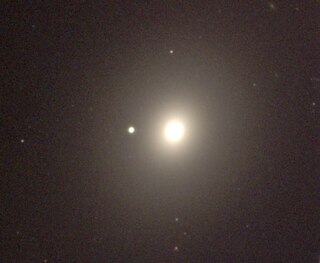
Messier 49 is a giant elliptical galaxy about 56 million light-years away in the equatorial constellation of Virgo. This galaxy was discovered by astronomer Charles Messier in 1777.
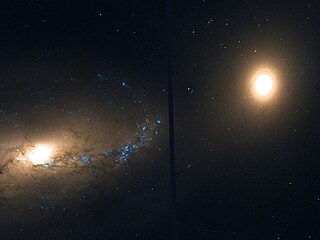
NGC 3226 is a dwarf elliptical galaxy that is interacting with the spiral galaxy NGC 3227. The two galaxies are one of several examples of a spiral with a dwarf elliptical companion that are listed in the Atlas of Peculiar Galaxies. Both galaxies may be found in the constellation Leo. It is a member of the NGC 3227 Group of galaxies, which is a member of the Leo II Groups, a series of galaxies and galaxy clusters strung out from the right edge of the Virgo Supercluster.

An ultraluminous X-ray source (ULX) is an astronomical source of X-rays that is less luminous than an active galactic nucleus but is more consistently luminous than any known stellar process (over 1039 erg/s, or 1032 watts), assuming that it radiates isotropically (the same in all directions). Typically there is about one ULX per galaxy in galaxies which host them, but some galaxies contain many. The Milky Way has not been shown to contain a ULX, although SS 433 may be a possible source. The main interest in ULXs stems from their luminosity exceeding the Eddington luminosity of neutron stars and even stellar black holes. It is not known what powers ULXs; models include beamed emission of stellar mass objects, accreting intermediate-mass black holes, and super-Eddington emission.
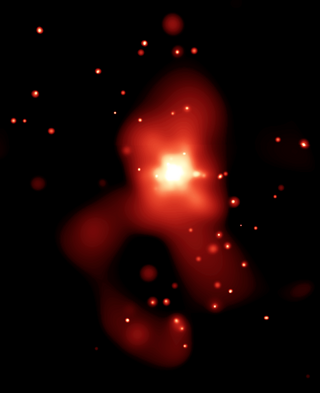
NGC 4261 is an elliptical galaxy located around 100 million light-years away in the constellation Virgo. It was discovered April 13, 1784 by the German-born astronomer William Herschel. The galaxy is a member of its own somewhat meager galaxy group known as the NGC 4261 group, which is part of the Virgo Cluster.
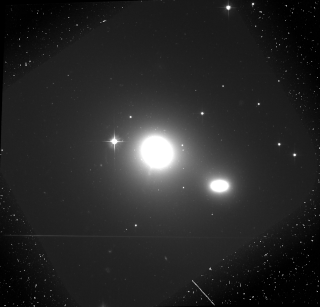
3C 66B is an elliptical Fanaroff and Riley class 1 radio galaxy located in the constellation Andromeda. With an estimated redshift of 0.021258, the galaxy is about 300 million light-years away.
Ursa Major II Dwarf is a dwarf spheroidal galaxy situated in the Ursa Major constellation and discovered in 2006 in the data obtained by the Sloan Digital Sky Survey. The galaxy is located approximately 30 kpc from the Sun and moves towards the Sun with the velocity of about 116 km/s. It has an elliptical shape with the half-light radius of about 140 pc.

NGC 4102 is an intermediate barred spiral galaxy located in the northern constellation of Ursa Major. It is visible in a small telescope and has an apparent visual magnitude of 11.2. The galaxy was discovered April 12, 1789 by William Herschel. J. L. E. Dreyer described it as "bright, pretty small, round, brighter middle and bright nucleus". This galaxy is located at a distance of 60 million light years and is receding with a heliocentric radial velocity of 837 km/s. It is a member of the Ursa Major group of galaxies.
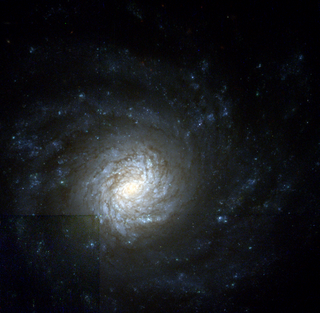
NGC 4041 is the New General Catalogue identifier for a spiral galaxy in the northern circumpolar constellation of Ursa Major. It is located an estimated 70 million light years from the Sun. The morphological classification of SA(rs)bc indicates this is a spiral galaxy the lacks a bar; the 'rs' means it has a weakly-formed ring structure, and the 'bc' indicates the spiral arms are moderately to loosely wound.

NGC 3642 is a spiral galaxy in the constellation Ursa Major. The galaxy has a low-ionization nuclear emission-line region. It is located at a distance of circa 30 million light years from Earth, which, given its apparent dimensions, means that NGC 3642 is about 50,000 light years across. The galaxy is characterised by an outer pseudoring, which was probably formed after the accretion of a gas rich dwarf galaxy.

NGC 708 is an elliptical galaxy located 240 million light-years away in the constellation Andromeda and was discovered by astronomer William Herschel on September 21, 1786. It is classified as a cD galaxy and is the brightest member of Abell 262. NGC 708 is a weak FR I radio galaxy and is also classified as a type 2 Seyfert galaxy.

NGC 7469 is an intermediate spiral galaxy in the constellation of Pegasus. NGC 7469 is located about 200 million light-years away from Earth, which means, given its apparent dimensions, that NGC 7469 is approximately 90,000 light-years across. It was discovered by William Herschel on November 12, 1784.

NGC 3367 is a barred spiral galaxy located in the constellation Leo. It is located at a distance of about 120 million light years from Earth, which, given its apparent dimensions, means that NGC 3367 is about 85,000 light years across. It was discovered by William Herschel on March 19, 1784.

NGC 7674 is a spiral galaxy located in the constellation Pegasus. It is located at a distance of circa 350 million light years from Earth, which, given its apparent dimensions, means that NGC 7674 is about 125,000 light years across. It was discovered by John Herschel on August 16, 1830.

NGC 4278 is an elliptical galaxy located in the constellation Coma Berenices. It is located at a distance of circa 55 million light years from Earth, which, given its apparent dimensions, means that NGC 4278 is about 65,000 light years across. It was discovered by William Herschel on March 13, 1785. NGC 4278 is part of the Herschel 400 Catalogue and can be found about one and 3/4 of a degree northwest of Gamma Comae Berenices even with a small telescope.

NGC 4800 is an isolated spiral galaxy in the constellation Canes Venatici, located at a distance of 95 megalight-years from the Milky Way. It was discovered by William Herschel on April 1, 1788. The morphological classification of this galaxy is SA(rs)b, indicating a spiral galaxy with no visual bar at the nucleus (SA), an incomplete ring structure (rs), and moderately-tightly wound spiral arms (b). The galactic plane is inclined to the line of sight by an angle of 43°, and the long axis is oriented along a position angle of 25°. There is a weak bar structure at the nucleus that is visible in the infrared.
References
- 1 2 3 "NASA/IPAC Extragalactic Database". Results for QSO B1030+585. Retrieved 2006-10-26.
- 1 2 Feinstein, Carlos; Macchetto, F. Duccio; Martel, André R.; Sparks, William B. (January 2002). "Filaments and Ionized Gas in the Vicinity of 3C 244.1". The Astrophysical Journal. 565 (1): 125–130. arXiv: astro-ph/0110409 . Bibcode:2002ApJ...565..125F. doi:10.1086/324604. S2CID 12148411.
- ↑ McLure, Ross J.; et al. (2004). "A sample of radio galaxies spanning three decades in radio luminosity - I. The host galaxy properties and black hole masses". Monthly Notices of the Royal Astronomical Society . 351 (1): 347–361. arXiv: astro-ph/0403106 . Bibcode:2004MNRAS.351..347M. doi:10.1111/j.1365-2966.2004.07793.x. S2CID 15474896.
- ↑ Daly, Ruth A. (February 2009). "Black Hole Spins of Radio Sources". The Astrophysical Journal Letters. 691 (2): L72–L76. arXiv: 0811.1897 . Bibcode:2009ApJ...691L..72D. doi:10.1088/0004-637X/691/2/L72. S2CID 119242789.